

Summary
Future global warming scenarios indicate the 1.5°C target laid out under the 2015 Paris Agreement is at risk, with some projections suggest a median global warming of as much as 2.8°C by 2100. Bridging the gap between emissions and mitigation necessitates immediate, comprehensive, and far-reaching strategies in energy, cities, transportation, demand mitigation, and carbon removal. Urgent and coordinated global action is imperative to address the escalating climate crisis. The 2023 U.N. Climate Change Conference meeting in Dubai serves as a critical juncture to assess progress, address gaps in mitigation efforts, and translate net-zero goals into impactful climate action.

Contents
The Trajectory of Greenhouse Gas Emissions
The Current Status of Global Climate Mitigation Efforts
Possible Global Warming Futures
Bridging the Gap Between Emissions and Mitigation
Mitigation Implementation in the Middle East and North Africa
Executive Summary
The trajectory of greenhouse gas (GHG) emissions, as outlined in the Intergovernmental Panel on Climate Change’s 2022 report, indicates a concerning pattern of steady increase since 1850. The fossil fuel industry remains the largest contributor, accounting for 59-65% of emissions from 1990-2019. After a temporary decline in 2020 due to the COVID-19 pandemic, emissions rebounded, hindering mitigation efforts. The cumulative carbon emissions from 2010-19 pose a significant challenge, representing four-fifths of the post-2020 carbon budget to limit global warming below 1.5°C.
While improvements in carbon intensity reduced emissions from fossil fuels, the overall impact was insufficient due to growing global activity in various sectors. Urban areas, responsible for 34% of GHG emissions in 2019, contribute increasingly to the global carbon footprint. Historical emissions vary regionally, with the Middle East contributing only 2% from 1850 to 2019, while North America and Europe both exceed 15%. Per capita, the top 10% of households contribute 34-45% of consumption-based GHG emissions.
The global climate mitigation landscape reflects progress with initiatives like the Kyoto Protocol and Paris Agreement, resulting in laws in 56 countries targeting 53% of global emissions. Costs for low-emission technologies have decreased since 2010, yet financing remains unevenly distributed. Climate financing growth has slowed, falling short of the $100 billion target by 2020.
Future global warming scenarios indicate challenges in achieving the 1.5°C target. Projections, even with updated nationally determined contributions, suggest a median global warming of 2.8°C by 2100. Mitigation in the fossil fuel sector is crucial, requiring transitions away from coal and extensive efforts in industry and transportation. Bridging the gap between emissions and mitigation necessitates immediate, comprehensive, and far-reaching strategies in energy, cities, transportation, demand mitigation, and carbon removal.
Detailed sector-specific recommendations include reducing fossil fuel dependency, scaling up carbon capture and storage, promoting renewables, enhancing urban design, adopting electric vehicles, managing energy demand, and exploring carbon removal techniques. Overcoming the mitigation challenge in the Middle East requires institutional capacity, financial resources, and commitment, especially from oil-producing nations. Renewables, behavioral changes, and carbon trading can all contribute significantly.
In conclusion, urgent and coordinated global action is imperative to address the escalating climate crisis. The 2023 U.N. Climate Change Conference meeting in Dubai, in the United Arab Emirates, serves as a critical juncture to assess progress, address gaps in mitigation efforts, and translate net-zero goals into impactful climate action. The stakes are high, with the 1.5°C target already at risk, emphasizing the need for decisive measures to avoid irreversible climate impacts.
Introduction
The release of the Intergovernmental Panel on Climate Change (IPCC) Sixth Assessment synthesis report in March 2023 signaled that the IPCC assessment cycle was coming to a close.1 The synthesis report will also serve as a supporting document in the current global stocktake process that will conclude at the 2023 U.N. Climate Change Conference (28th Conference of the Parties, COP28) in Dubai, in the United Arab Emirates. The following is an analysis of the final report of this assessment cycle from Working Group III that focused on the mitigation of climate change ahead of COP28, to provide insight on the future of potential climate action in the context of the Middle East and North Africa.2 MEI’s previous analysis on the IPCC Sixth Assessment cycle examined the implications of future climate for the Mediterranean3 and what the first report from Working Group I, based on the physical science, indicated would be the broader challenges to the MENA region in terms of climate change impacts.4
The Trajectory of Greenhouse Gas Emissions
Greenhouse gas (GHG) emissions have been steadily increasing since 1850, with the largest source being carbon emissions from the fossil fuel industry (responsible for 59-65% of emissions from 1990-2019). When looking at progressive decades from 1850 onward, the period of 2010-19 had the highest annual average of GHG emissions. In fact, this same period accounts for 17% of all carbon emissions since 1850. And even though carbon emissions from the fossil fuel industry temporarily declined in early 2020 due to the COVID-19 pandemic, they rebounded by the end of that year.
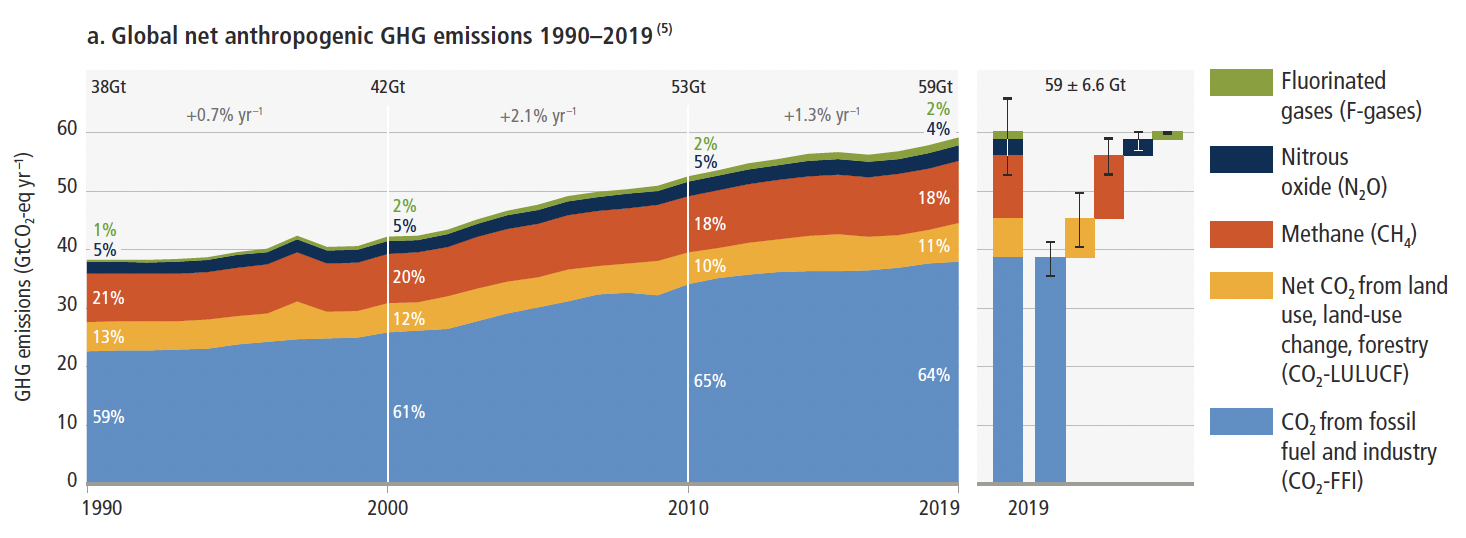
S. Some, P. Vyas, R. Fradera, M. Belkacemi, A. Hasija, G. Lisboa, S. Luz, J. Malley, (eds.)]. Cambridge University Press, Cambridge, UK and New York, NY, USA.
The high carbon emission activity in the most recent decade constrains mitigation efforts to limit future global warming below critical thresholds. Estimates indicate that the cumulative carbon emissions generated between 2010 and 2019 amount to about four-fifths of the remaining carbon budget post-2020 needed to keep global warming below 1.5°C. Similarly, based on estimates, carbon emissions during this period amount to one-third of the remaining carbon budget for 2020 onward required to keep global warming below 2°C.
Carbon emissions from fossil fuels and industrial processes have declined due to improvements in the carbon intensity of energy generated (carbon from fossil fuel combustion and industrial processes per unit of energy). Between 2010 and 2019, carbon intensity decreased by 0.3% per year as more fuel was sourced from natural gas than coal, overall coal generating capacity was reduced, and the amount of energy generated by renewables increased. To curb future global warming between 2020 and 2050, carbon intensity would need to decrease globally by 3.5% per year to limit warming to 2°C and by 7.7% per year to limit warming to 1.5°C.
However, the recent reduction in carbon emissions due to improved carbon intensity has not been sufficient to offset increases in carbon emissions from growing global activity in the sectors of industry, energy supply, transportation, agriculture, and building structures. As of 2019, approximately 34% of GHG emissions came from the energy supply sector, 24% from industry, 22% from agriculture, 15% from transport, and 6% from buildings. Consequently, and due to a number of complex drivers such as population size, income, and urbanization, an increasing share of global carbon emissions can be attributed to urban areas, rising from 62% in 2015 to 67-72% in 2020.
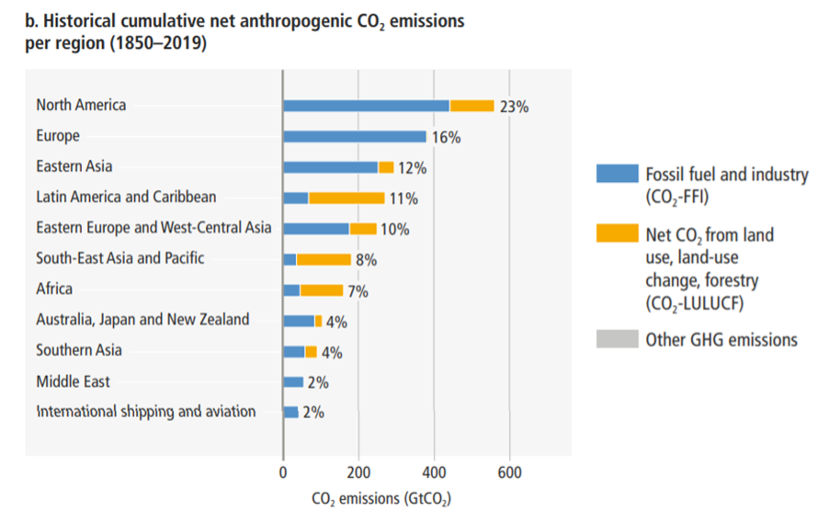
From a historical perspective, global GHG emissions contributions have varied from region to region. Though much of the recent focus on decarbonization has fallen on fossil fuel-producing countries in the Middle East, that region only contributed about 2% of global cumulative carbon emissions from 1850-2019, the lowest such regional contribution. In contrast, emission contributions from North America and Europe both exceeded 15% for that same period, at 23% and 16% respectively.
When distilled to global per capita emissions, the top 10% of households in terms of per capita emissions contribute 34-45% of all consumption-based household GHG emissions, while the bottom 50% of households contribute only 13-15%. These low-carbon-emitting households likely correspond with the least developed countries in the world, which contributed less than 0.4% of cumulative fossil fuel and industry carbon emissions from 1850 to 2019. A significant portion of the population in less developed and low-emission countries do not have access to modern energy services and utilities. However, eliminating energy poverty in these countries can still be achieved without substantially expanding global emissions.
The Current Status of Global Climate Mitigation Efforts
The 1997 Kyoto Protocol, which came into force in 2005, was successful in transitioning countries toward building capacity for expanded (national and international) accounting and reporting of GHG emissions. The 2015 Paris Agreement, which entered into force in 2016, built on this progress by motivating its worldwide signatories to set national and sectoral goals for developing climate mitigation and adaptation policies, targets, and strategies. Mitigation policy applications have become more commonplace since the advent of these international climate treaties. As of 2020, climate-specific laws that targeted GHG emission reductions were in place in 56 countries, and if fully and successfully implemented would account for 53% of global emissions. These policies have resulted in slashed carbon emissions for many nations due to mitigation actions that have improved energy efficiency, reduced deforestation, and amplified the deployment of supporting technologies. There are still opportunities though to widen the limited coverage of climate policies that deal with emissions from the agricultural and industrial materials sectors, among others.
Since 2010, the costs of low-emission and renewable energy technologies have dropped significantly, falling by more than 55% for lithium-ion batteries and solar and wind energy on a per unit basis, while the utilization and deployment of such technologies has greatly increased. Technological innovations have helped make these types of technologies more cost effective and efficient in reducing emissions. And while the expanded proliferation of low-emission technologies provides more opportunities for social, environmental, and economic benefits, a couple of shortcomings remain. One is the potential for increased electronic waste (and its negative consequences for the environment) as these digital technologies continue to be widely adopted. And second, the adoption of low-emission and renewable energy technologies, even at lower costs, is still limited in developing countries because of restricted funding, technology development, and capacity for implementation.
Annual climate financing for mitigation and adaptation grew by 60% between 2013 and 2020. But most of the financing disproportionately favors mitigation and is unevenly distributed among regions and sectors.5 Furthermore, average climate finance growth declined between 2018 and 2022, likely a contributing factor to why climate financing from developed to developing countries fell below the target of $100 billion by 2020 for mitigation action, as laid out by the U.N. Framework Convention on Climate Change (UNFCCC) and the Paris Agreement.
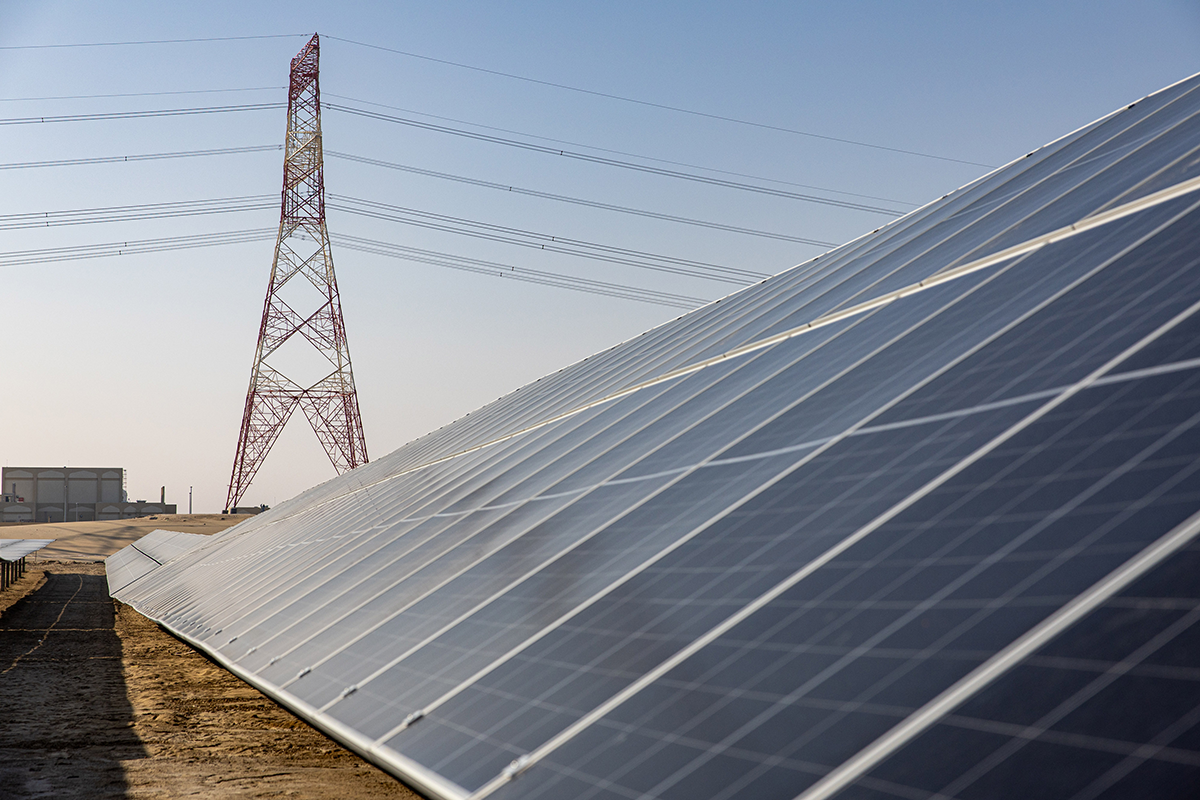
Possible Global Warming Futures
Keeping future average global warming increases to below the temperature thresholds of 1.5°C or 2°C is contingent on the implementation of climate mitigation policies that can effectively reduce GHG emissions. However, the likelihood of limiting warming to below the 1.5°C threshold target has dropped due to the rise of GHG emissions from 2017 onward, indicating higher projected emissions by 2030 and a later timeline to achieve net-zero emissions. In fact, projections of future global emissions that include updated nationally determined contributions (NDCs) that were announced by many nations ahead of COP26 do result in GHG emissions that are greater than what was intended from implementing those revised NDCs. So much so that if these NDCs are maintained until 2030, with no additional plans for emission reductions, modeled projections result in a median global warming of 2.8°C by the end of this century.
In terms of the impact of emissions from the fossil fuel-based energy sector, if the current level of fossil fuel infrastructure operations persists without additional abatement, projections indicate that the resulting cumulative carbon emissions would lead to future global warming exceeding the 1.5°C threshold while barely remaining below the 2°C limit. In fact, keeping future global warming below the 2°C limit while moving toward the global net-zero carbon target will require emission reductions from beyond the energy sector (such as from industry and transportation). But the main mechanism to achieve a net-zero carbon future will not be possible without climate mitigation from the fossil-fuel energy sector through efforts such as fully transitioning away from coal power plants, retrofitting fossil-fuel infrastructure with carbon capture and sequestration technologies, and reducing reliance on the fossil-fuel side of the energy market. According to modeled projections where global net-zero GHG emissions are achieved by 2050, almost 75% of global emissions reductions will need to come from carbon emission reductions in global energy supply and demand.6
Bridging the Gap Between Emissions and Mitigation
It is clear that bridging the gap between the current projected trajectory of emissions and target future emissions to keep global warming below the 2°C threshold will require immediate action to rapidly deploy enhanced mitigation efforts to persist beyond 2030. And while accelerating mitigation strategies requires overcoming the challenges of rapidly scaling up and the costs associated with ramping up implementation, the potential economic benefits gained by avoiding the worst damages from climate impacts (due to resolute climate action) increases when climate mitigation strategies are more comprehensive and far-reaching. Modeled projections that constrain future warming to below 2°C all include rapid and deep reductions to GHG emissions to make that possible. This is feasible if a number of sectors work in concert — specifically those related to energy, cities, transportation, demand mitigation, and carbon dioxide removal — so that any shortfall in mitigation action from one sector can be compensated by emission reductions in others.
Energy Sector
Fossil Fuel Use Reduction: Ensuring that energy systems and infrastructure are net zero in terms of carbon emissions will require substantially reducing the dependency on fossil fuels, scaling up carbon capture and storage (CCS) in fossil fuel-based energy generation and consumption, and limiting the use of unabated fossil fuels. Simultaneously, the electrification of systems, technologies, and processes that have traditionally relied on fossil fuels, along with energy efficiency and conservation measures, can put into place net-zero carbon electricity systems.7 The transition away from fossil fuels in an effort to limit future global warming to below 2°C will result in a substantial amount of fossil fuels remaining unburned, consequently stranding considerable fossil fuel-based infrastructure. And while CCS may allow for an extended usage of fossil fuels into the future (thus reducing stranded assets), projections that limit global warming to 2°C allude to the risk that coal assets may be stranded by 2030, with oil and gas assets following suit by mid-century.8
Renewables and Low-Emission Energy Generation: Using renewables and low-emission sources of energy as a main source of electricity has become increasingly viable and cost-effective. Reductions in the cost of technologies that can support renewables (such as for wind power, solar power, and energy storage) have made these low-emission energy sources more attractive — so much so that for some countries, continuing to utilize traditionally more emission-intensive systems may be more costly than transitioning to renewables and low-emission energy sources. Though some countries already significantly use renewables to power their electric systems, making the shift to supply electricity completely from renewables is quite difficult due to operational, economic, and technological challenges and constraints. But increasing the share of renewables in the energy portfolios of countries is possible through mechanisms such as smart energy grids, large-scale energy storage, and improved energy demand management.
Carbon Capture and Storage: The current rate of CCS implementation worldwide to reduce emissions from fossil fuel sources is insufficient to limit future global warming to under 1.5°C or 2°C. In addition to the obstacles with the still-developing technology when it comes to direct air carbon capture, the cost of CCS implementation, and environmental considerations, the widespread deployment of CCS is also limited by the availability of geological storage to trap the captured carbon. Given an appropriately selected and well-managed geological storage site, CCS can effectively isolate the stored carbon from the atmosphere, thus negating that carbon from contributing to global warming.
Cities and Municipalities
Carbon-Neutral Urban Design: Rapidly growing cities and urban areas can minimize future GHG emissions through energy efficiency improvements in infrastructure and city services that utilize low-emission technologies. This can be coupled with the electrification of cities using low-emission energy sources. Cities can also encourage an environmentally sustainable way of life for urban residents by focusing on compact urban design that makes the use of public transportation and non-motorized conveyance (such as walking or bicycling) more palatable. In addition, sustainable urban planning and design can take into consideration the inclusion of zones and infrastructure that naturally capture and store carbon emissions in the urban environment. City parks, neighborhood lakes and ponds, and green spaces on or around buildings with trees and vegetation all provide mitigation (and adaptation) benefits. Even changes in the type of building materials help to keep cities cooler and reduce GHG emissions, while also lessening the impact of the urban heat island effect.9
Long-Term Municipal Planning: Urban areas have been incorporating climate mitigation strategies in their municipal development plans in order to meet local net-zero emission targets. Implementation of such strategies is either constrained or enabled by a municipality’s governance and regulatory structure, as well as its available financial and technological resources. The scope of these strategies will depend on a municipality’s spatial extent, its level of urbanization and state of development, and the types of land use within its boundaries.

Transportation
Electric Vehicles (EVs): A wider adoption of EVs that are powered from low-emission sources of energy has the potential to reduce GHG emission from the transportation sector. The rate of adoption and usage of EVs has increased as their purchase price has fallen. However, scaling up the use of EVs is contingent on providing the necessary supporting infrastructure, such as sufficient numbers of recharging stations, especially outside of urban areas. Additionally, advancements in battery storage and battery technologies can expand the viability of EVs from personal vehicles to commercial and industrial heavy operation vehicles that are traditionally powered by fossil fuels. With a potentially more mainstreamed usage of EVs, there are some concerns about being able to sustainably source the critical minerals that are needed to produce batteries.
Alternative Low-Emission Fuels: For transportation needs that are more long distance, such as for global aviation and shipping, electrification of these modes of transportation is not currently feasible. Electrification in aviation and shipping could be possible for shorter-duration travel of airplanes and ships, where airports and ports could incorporate the supporting infrastructure needed to power these modes of transportation, thus reducing a portion of emissions from flying and shipping operations. Besides efficiency improvements in how airplanes and ships utilize energy, mitigation of emissions from these transportation modes will be predominantly achieved through the use of alternative low-emission fuels such as biofuels, low-emission hydrogen, and synthetic fuels.
Sustainable Urban Mobility: Social and behavioral changes can also play a role in mitigating emissions, especially in urban environments. More teleworking, use of public transportation, shared modes of mobility (e.g. carpooling), and non-motorized movement (e.g. via bicycle or walking) by humans can reduce the demand for traditional transportation means that have historically relied on fossil fuels. This in turn would have the cascading effect of reducing carbon emissions from urban areas.
Demand Mitigation
Energy Demand Management: GHG emissions can be curbed when the demand for energy is reduced; in other words, less energy consumption translates to diminished energy generation and emissions. Energy demand mitigation is greatly influenced by social behavioral changes that affect the rate of energy use. As such, opportunities for reduced GHG emissions through demand mitigation can be realized in the sectors of construction (buildings), transportation, and food — as an extension of social services related to shelter, sanitation, mobility, nutrition, and water. Up to 30% of annual GHG emissions globally are avoidable by 2050 through adjustments that reduce energy consumption from these sectors. For example, changes in the built environment and infrastructure can promote more compact cities with more energy-efficient buildings that minimize the distance between housing and places of employment, resulting in an overall reduction in energy demand (and thus emissions).
Behavioral Changes: Socio-economic status has a significant influence on personal energy consumption. People at a higher socio-economic status contribute disproportionately to emissions as a consequence of wasteful and unsustainable lifestyle behaviors that inefficiently and excessively consume energy. These individuals thus have the greatest potential for emission reductions by adopting behavioral changes that are more environmentally sustainable, such as maintaining healthy diets with minimal food waste, using and reusing non-consumable products to the full extent of their useful lifespan, sharing vehicles and carpooling, and integrating low-emission and renewable energy sources in their homes.
Carbon Dioxide Removal
Geological and Ocean Sequestration: Removing carbon dioxide from the atmosphere and storing it in other carbon “reservoirs” has the net effect of lowering carbon and GHG emissions. Sustained emission reductions through this approach have the benefit of offsetting emissions that are difficult to completely negate (such as from long-distance global shipping and aviation). Natural carbon sinks like the ocean and geological formations can durably store absorbed carbon dioxide in timescales exceeding tens of thousands of years, and that process is difficult to reverse through anthropogenic or natural means.
Vegetation and Soil Management: In terms of active methods of carbon dioxide removal, reforestation, afforestation, forest management, and soil carbon sequestration are the most widely used. Depending on the type of carbon dioxide removal method deployed (and how it is implemented), there are risks and benefits to ecosystems, biodiversity, and humans. For example, if poorly implemented and not sustained, afforestation methods may have adverse impacts on biodiversity, food/water security, and the socioeconomic conditions of local populations relying on the potential benefits of afforestation. Unlike geological and ocean sequestration, carbon storage in vegetation through soil management occurs on a timescale of decades to centuries. But climate change, along with human or natural disturbances, can reverse the achieved removal and storage of carbon dioxide through vegetation and soil carbon sequestration.
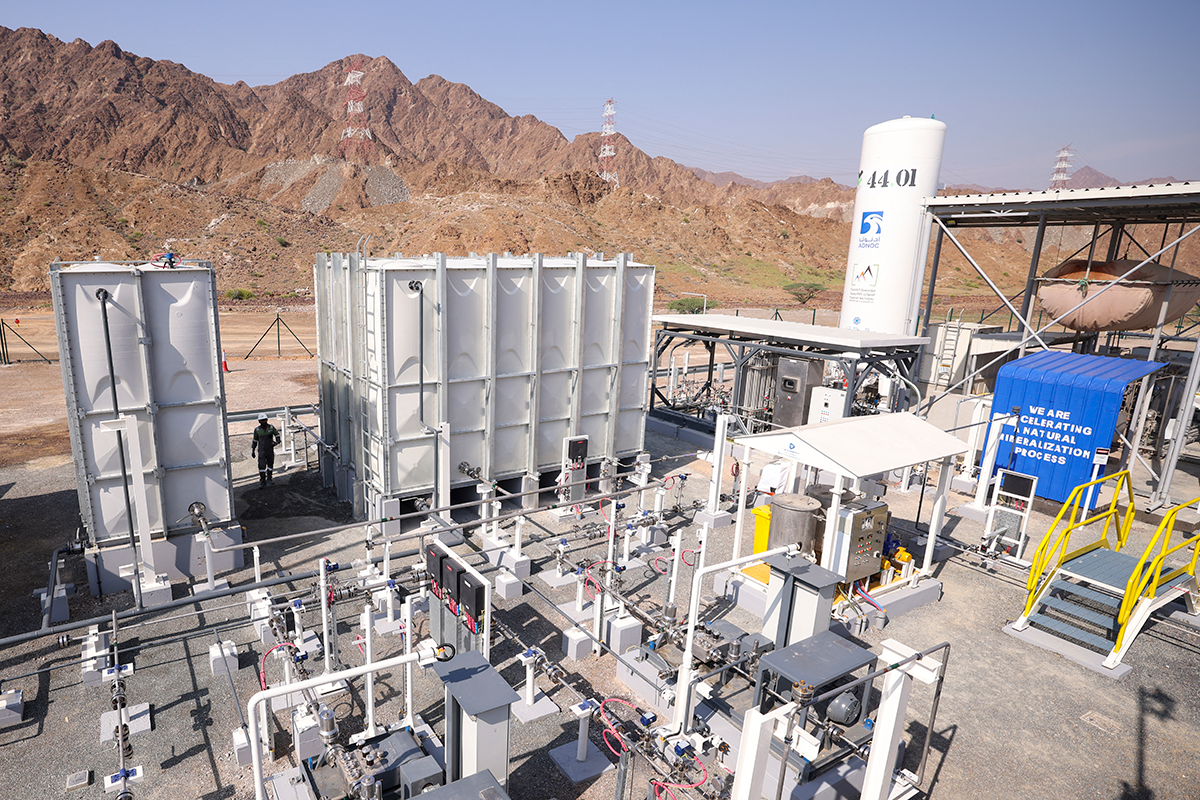
Mitigation Implementation in the Middle East and North Africa
When it comes to MENA countries, bridging the gap between the current projected trajectory of emissions and target future emissions in the energy, cities, transportation, demand mitigation, and carbon dioxide removal sectors is contingent on their institutional and financial capacity to implement climate action. From an institutional capacity perspective, some countries in the region are better positioned to implement climate mitigation than others, for a variety of reasons. Putting aside nations that are under active civil conflict or where stability and governance is volatile (such as Sudan, Libya, and Yemen), the main indicator of countries’ capacity to deal with climate change is how well climate change and climate action is mainstreamed (if it all) into their governance and institutional structures. For example, some nations in the region have dedicated arms of the government to managing climate change efforts (e.g. the UAE’s Ministry of Climate Change and Environment and Qatar’s Ministry of Environment and Climate Change), or assigned climate envoys (such as the case with Saudi Arabia and Iraq).
Even with reliable institutional capacity, the availability of financial resources to address emissions and put into action climate mitigation can either be an enabling or prohibiting factor. The availability of funds (and the incentive to utilize them) for climate mitigation strategies is also a factor that separates the more developed and less developed countries in the region. Though several mitigation strategies, such as solar and wind energy, have become more technically viable and cost effective, the funding gap for developing countries is still wide across all potential sectors of mitigation. In addition to institutional capacity barriers that developing countries may face, lack of climate financing options in the region is another challenge that needs to be overcome.10
With respect to mitigation in the Middle East’s energy sector, much scrutiny and attention is placed on the oil-producing nations of the Gulf — a region that produces a fifth of the world’s oil supply and is home to over 50% of the planet’s oil reserves.11 These countries are faced with complex decisions when it comes to mitigation, as the revenue generated from their oil and gas production to sustain their economies is also used to fund expanded decarbonization, renewables, and CCS initiatives. Despite this ongoing challenge (or even because of it), the countries of the Gulf Cooperation Council (GCC) have laid out ambitious visions and goals aimed at reducing future emissions and curbing global warming, with key examples being the Saudi Green Initiative’s Circular Carbon Economy concept and the UAE’s National Energy Strategy 2050.12 There is clear recognition from the various net-zero goals and supporting initiatives that the GCC nations have put forth that proactive mitigation action will blunt the effect that global climate policies will have on their fossil fuel-based economies.13
Achieving the goal of net-zero carbon emissions in the region will require the efforts of countries beyond the GCC as well. The participation of less emission-producing nations and the ramping up of mitigation efforts by moderate emission producers is needed. But even more important, countries that are holdouts from ratifying the Paris Agreement must also formally join the global coalition that has made commitments to reducing GHG emissions. The three remaining countries that have yet to ratify the Paris Agreement are in the MENA region: Libya, Yemen, and Iran. Securing Iran’s commitment to ratify the agreement would be a huge step forward globally and in the region, as it is one of the top carbon-emitting countries in the world.14
The potential for renewables, particularly solar, is very promising in the MENA region. Ample land and an abundance of incoming solar radiation, along with decreasing material costs for solar panels, are motivating factors for the proliferation of solar farms. This is in spite of some of the limitations of deploying solar plants in the region, specifically the impact that extremely high temperatures have on solar panel energy output and the inhibiting effect of the region’s dust storms.15
Electrification and alternative low-emission fuels will be key components in how cities and urban transportation contribute to climate mitigation in MENA. This will be necessary to offset urban emissions associated with daily car commutes, maritime shipping, and air travel. EV usage has increased in the region, particularly in the UAE and Saudi Arabia.16 The challenge with transitioning to EVs as a sustainable, low-emission alternative for commuter transportation in the region hinges on three main issues: making an adequate number of charging stations available to enable expanded use of EVs, reducing the environmental impacts of mining the materials necessary to support the manufacturing of EVs, and ensuring that the energy used to charge EVs comes (at least mostly) from renewables and not high-emission energy sources.17
Hydrogen has been touted as a low-emission alternative to energy derived from fossil fuels. But depending on the type and source of hydrogen, their contribution to emissions varies.18 For example, though gray hydrogen when used as a fuel does not generate GHG emissions, the process to produce it (from natural gas) does, since those emissions are not captured during production. As such the focus in the region, particularly for the GCC, has shifted to blue and green hydrogen; emissions are captured and stored in the production of blue hydrogen while green hydrogen, produced using renewable energy, generates no emissions.19
Behavioral changes in the region’s citizens that could push them toward consuming less energy (and thus reduce emissions on a per capita energy consumption basis) may be slow to occur. Local surveys across the region indicate that citizens do not view climate change as a leading environmental issue.20 Relatedly, survey results suggest that citizens would like their governments to do more to address climate change, but if they cannot, citizens are satisfied with their governments’ current level of effort with respect to climate change adaptation and mitigation. Encouraging more citizen awareness about the effects of the climate crisis in the region, such as through education and outreach efforts, will likely be necessary to propel a shift in local attitudes toward more climate-adaptive behavior.
The mainstreaming of carbon markets and carbon trading in the region (as outlined by Article 6 of the Paris Agreement) can offer incentives for carbon dioxide removal.21 This can be achieved through avoidance measures such as the energy transition toward renewables and improvements in energy efficiency, or through CCS methods — both in industrial production of fossil-fuel-based energy or nature-based sequestration. Nature-based approaches to mitigation, especially those focused on coastal systems, such as the restoration of mangroves, have the added benefit of reducing coastal erosion and protecting against the future risks of sea level rise.22
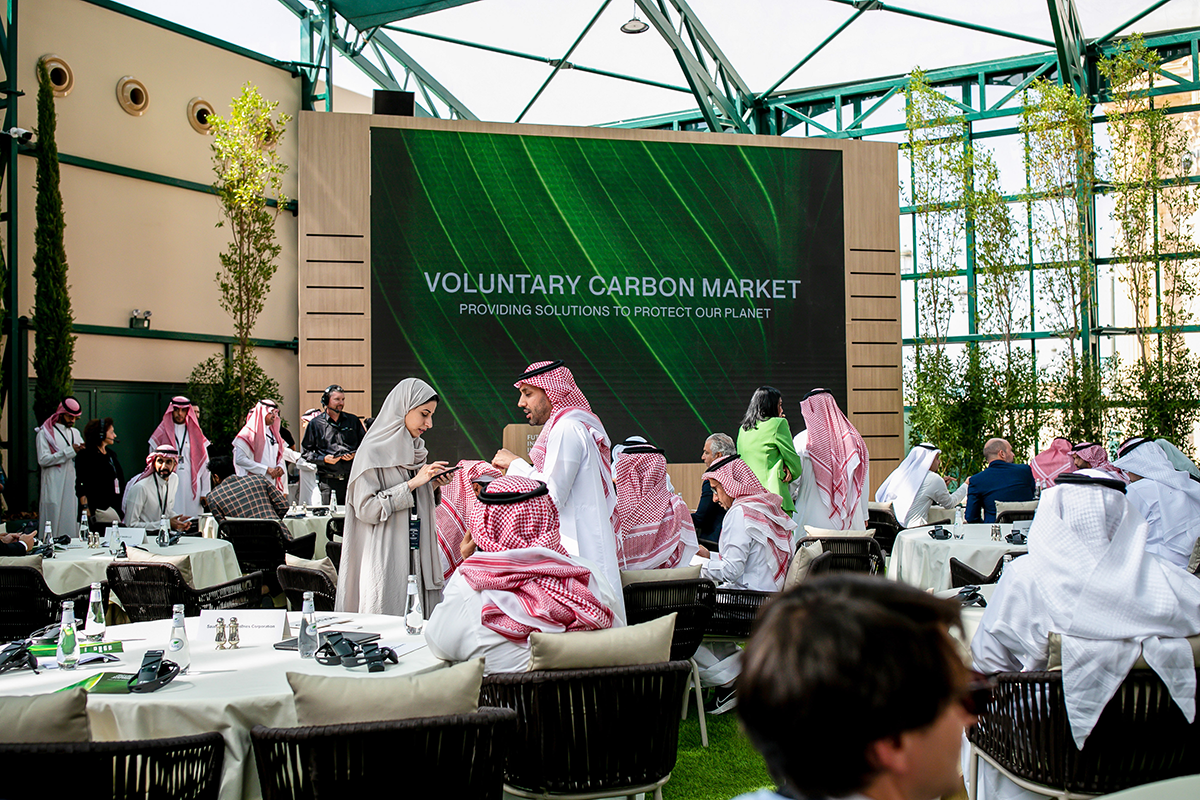
Policy Recommendations for Climate Mitigation Action
Based on the analysis provided by the IPCC Sixth Assessment cycle and the current state of global climate mitigation, the following are key policy recommendations in a number of areas that can address the shortfall in mitigation efforts to curb the projected trajectory of GHG emissions, emphasizing the need for immediate and comprehensive action on both a global scale and within the MENA region.
Global Cooperation and Commitment
-
Encourage all UNFCCC parties, especially major GHG emitters, to strengthen their commitment to climate mitigation, aligning with the goals of the Paris Agreement.
-
Promote international collaboration to address the global nature of climate change, recognizing that regional disparities exist in historical contributions to emissions.
Energy Sector
-
Implement policies to rapidly transition away from dependency on fossil fuels, scaling up CCS and limiting the use of unabated fossil fuels.
-
Incentivize the electrification of systems and technologies, promoting energy efficiency, and investing in renewable energy sources.
-
Support research and development in energy storage technologies to enhance the viability of renewable energy sources.
Cities and Municipalities
-
Promote carbon-neutral urban design and sustainable urban planning to minimize emissions from rapidly growing cities.
-
Encourage energy-efficient infrastructure, public transportation, and non-motorized conveyance to reduce emissions associated with urban living.
-
Facilitate long-term municipal planning that incorporates climate mitigation strategies, considering each municipality's unique characteristics and resources.
Transportation
-
Accelerate the adoption of EVs by investing in the necessary supporting infrastructure, especially outside urban areas.
-
Develop and promote alternative low-emission fuels for long-distance transportation, such as biofuels and synthetic fuels.
-
Encourage sustainable urban mobility practices, including teleworking, public transportation, shared mobility, and non-motorized transport.
Demand Mitigation
-
Implement energy demand management strategies to reduce overall energy consumption, focusing on sectors like construction, transportation, and food.
-
Encourage behavioral changes, especially among high-income households, to adopt environmentally sustainable practices and reduce energy-intensive lifestyles.
Carbon Dioxide Removal
-
Invest in geological and ocean sequestration methods for carbon dioxide removal.
-
Promote vegetation and soil management, including reforestation and afforestation, as active methods of carbon dioxide removal.
-
Explore the potential of carbon markets and trading to incentivize carbon dioxide removal initiatives.
Mitigation Implementation
-
Provide support in building institutional capacity for countries in the MENA region to implement climate mitigation actions.
-
Address the financial barriers to climate action in the region by facilitating climate financing options for developing countries.
-
Leverage the region's potential for renewables, particularly solar energy, and support ambitious goals for net-zero emissions.
Global Climate Governance
-
Strengthen global climate governance mechanisms, ensuring that commitments made by UNFCCC parties are transparent, verifiable, and aligned with the latest climate science.
-
Encourage the ratification of international climate-associated agreements, especially in regions where key contributors to emissions have not yet joined the global coalition.
Call for Action
-
Emphasize the urgent need for enhanced mitigation efforts beyond 2030 to bridge the gap between current emission trajectories and a net-zero carbon future.
-
Highlight the economic benefits of comprehensive and far-reaching mitigation strategies, emphasizing the importance of avoiding the worst outcomes from future climate impacts.
Conclusion
Anthropogenic climate change propelled by nearly two centuries of unabated and unmitigated greenhouse gas emissions has yielded warming impacts that have disrupted multiple spheres of human life due to droughts, global warming, and extreme weather, and threaten the environmental sustainability of our planet. Without corrective mitigation action, continued patterns of energy use, land development, industrial production, and human consumption could propel the earth, and especially extreme heat-prone regions like MENA, into an irreversible climate regime that could prove uninhabitable.
Multiple efforts on the global stage have been put into place to address the acceleration of dangerous climate change impacts, anchored by the Kyoto Protocol, Paris Agreement, and the work of the UNFCCC through the annual COP meetings. The development of the NDCs for each global party as a target toward transparent emission reporting and reduction is a critical international and cooperative mitigation milestone. But without sufficient action, implementation, and financing to help nations achieve their NDCs, the world will fall short of avoiding alarming thresholds of future global warming.
The goal of limiting future global warming to below 1.5°C is already at serious risk of being breached, after a year of unprecedented temperatures that is on track to becoming the warmest on record.23 Such an extraordinary year of climate extremes makes this year’s U.N. Climate Change Conference in Dubai all the more pressing. At the COP28 meeting, the two-year global stocktake process will come to a close, providing an updated benchmark of where the world is with respect to meeting the goals of the Paris Agreement, and the likely wider gap of mitigation that now exists to manage and curb further increases in global warming. The outcomes of COP28 may serve as a last call for meaningful and impactful climate mitigation, as well as provide a renewed urgency to translate net-zero emission goals into climate action.
About the Author
Mohammed Mahmoud is the Director of the Climate and Water Program and a senior fellow at MEI. His areas of expertise include climate change adaptation, water policy analysis, and scenario planning. Mohammed has held leadership positions in several organizations, including that of Chair of the Water Utility Climate Alliance, a coalition of 12 of the United States’ largest water utilities that collectively provide water to over 50 million people, with the purpose of providing leadership and collaboration on climate change issues that affect water agencies. Furthermore, he regularly provides subject matter interviews in press, audio, and video media on climate-associated topics such as regional climate change impacts, water resources management, extreme heat, droughts, and the food-water-energy nexus.
Endnotes
1 IPCC, Climate Change 2023: Synthesis Report (Geneva: IPCC, 2023), 33-115, https://www.ipcc.ch/report/sixth-assessment-report-cycle/.
2 IPCC, Climate Change 2022: Mitigation of Climate Change (Cambridge: Cambridge University Press, 2022), https://www.ipcc.ch/report/sixth-assessment-report-working-group-3/.
3 Gökçe Şencan, “What the United Nations’ 6th Climate Assessment tells us about the Mediterranean’s climate future,” Middle East Institute, Dec. 19, 2022. Accessed Nov. 10, 2023, https://mei.edu/publications/what-united-nations-6th-climate-assessment….
4 Mohammed Mahmoud, “The IPCC Sixth Assessment Report on Climate Change and what it means for the Middle East,” Middle East Institute, Oct. 25, 2021. Accessed Nov. 11, 2023, https://mei.edu/publications/ipcc-sixth-assessment-report-climate-chang….
5 UNEP Adaptation Gap Report 2023: Underfinanced. Underprepared – Inadequate investment and planning on climate adaptation leaves world exposed, https://www.unep.org/resources/adaptation-gap-report-2023?gclid=CjwKCAjwkY2qBhBDEiwAoQXK5V3xVW-WNMcSniAg0vAfrAc9V5SjzuO5RWPYeah2CkKOCL3ez4aX_hoCnQAQAvD_BwE.
6 Riahi, K., R. Schaeffer, J. Arango, K. Calvin, C. Guivarch, T. Hasegawa, K. Jiang, E. Kriegler, R. Matthews, G.P. Peters, A. Rao, S. Robertson, A.M. Sebbit, J. Steinberger, M. Tavoni, D.P. van Vuuren, 2022: Mitigation pathways compatible with long-term goals. In IPCC, 2022: Climate Change 2022: Mitigation of Climate Change. Contribution of Working Group III to the Sixth Assessment Report of the Intergovernmental Panel on Climate Change[P.R. Shukla, J. Skea, R. Slade, A. Al Khourdajie, R. van Diemen, D. McCollum, M. Pathak, S. Some, P. Vyas, R. Fradera, M. Belkacemi, A. Hasija, G. Lisboa, S. Luz, J. Malley, (eds.)]. Cambridge University Press, Cambridge, UK and New York, NY, USA. doi: 10.1017/9781009157926.005, https://www.ipcc.ch/report/ar6/wg3/chapter/chapter-3/.
7 IEA, “Electrification – Energy System,” IEA. Accessed Nov. 11, 2023, https://www.iea.org/energy-system/electricity/electrification.
8 Konstantin Löffler, Thorsten Burandt, Karlo Hainsch, Pao-Yu Oei, Modeling the low-carbon transition of the European energy system - A quantitative assessment of the stranded assets problem, Energy Strategy Reviews, Volume 26, 2019, 100422, ISSN 2211-467X, https://doi.org/10.1016/j.esr.2019.100422.
9 UCAR Center for Science, “Urban Heat Islands | Center for Science Education,” Center for Science Education. Accessed Nov. 11, 2023, https://scied.ucar.edu/learning-zone/climate-change-impacts/urban-heat-….
10 Zeina Moneer, “The intricacies of climate finance in the MENA region: Challenges and the way forward,” Middle East Institute, Feb. 24, 2023. Accessed Nov. 11, 2023, https://mei.edu/publications/intricacies-climate-finance-mena-region-ch….
11 Karim Elgindy, “In the eye of the storm: The battle over fossil fuels at COP28,” Middle East Institute, Oct. 11, 2023. Accessed Nov. 11, 2023, https://mei.edu/publications/eye-storm-battle-over-fossil-fuels-cop28-0.
12 Athra Khamis, “Breaking down the details of the UAE’s climate strategy,” Middle East Institute, Aug. 1, 2023. Accessed Nov. 11, 2023, https://mei.edu/publications/breaking-down-details-uaes-climate-strategy.
13 Aisha Al-Sarihi, “The GCC and the road to net zero,” Energy Oman Magazine, June 25, 2023. Accessed Nov. 26, 2023, https://energyoman.net/the-gcc-and-the-road-to-net-zero.
14 Maia Golzar Anderson, “Bringing Iran to the climate action table,” Middle East Institute, Sept. 22, 2023. Accessed Nov. 11, 2023, https://mei.edu/publications/bringing-iran-climate-action-table.
15 Hamid Pouran, “The Middle East’s dust storms are making it harder to deploy solar energy,” Middle East Institute, July 21, 2022. Accessed Nov. 11, 2023, https://mei.edu/publications/middle-easts-worsening-dust-storms-are-mak….
16 Andrei Covatariu, “Urban pollution across the Middle East and Black Sea regions: Causes and mitigation measures,” Middle East Institute, July 14, 2022. Accessed Nov. 11, 2023, https://mei.edu/publications/urban-pollution-across-middle-east-and-bla….
17 Athra Khamis, “The environmental cost of electric vehicles,” Middle East Institute, June 29, 2023. Accessed Nov. 11, 2023, https://mei.edu/publications/environmental-cost-electric-vehicles.
18 Acciona, “What are the colours of hydrogen and what do they mean?” Acciona, June 16, 2023. Accessed Nov. 11, 2023, https://www.acciona.com.au/updates/stories/what-are-the-colours-of-hydr…
19 Achref Chibani, “Hydrogen as a fuel of the future: Moving the GCC’s climate mitigation agenda forward,” Middle East Institute, Sept. 5, 2023. Accessed Nov. 11, 2023, https://mei.edu/publications/hydrogen-fuel-future-moving-gccs-climate-m….
20 Mohammed Mahmoud, “Citizen priorities on the environment and climate change in MENA,” Middle East Institute, Feb. 14, 2023. Accessed Nov. 11, 2023, https://mei.edu/publications/citizen-priorities-environment-and-climate….
21 Zeina Moneer, “Carbon trading in the MENA region: Opportunities and challenges,” Middle East Institute, Oct. 9, 2023. Accessed Nov. 11, 2023, https://mei.edu/publications/carbon-trading-mena-region-opportunities-a….
22 Zeina Moneer, “Is blue the new green? Opportunities for developing a climate-resilient blue economy in the MENA region,” Middle East Institute, May 11, 2023. Accessed Nov. 11, 2023, https://mei.edu/publications/blue-new-green-opportunities-developing-cl….
23 Middle East Institute, “Expert Voices | Mohammed Mahmoud on Extreme Heatwaves,” YouTube video, Aug. 2, 2023. Accessed Nov. 11, 2023, https://www.youtube.com/watch?v=vsRK91KXJjQ.










